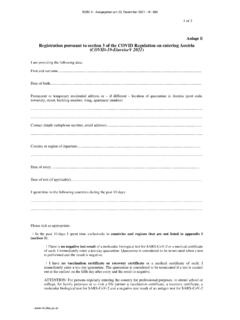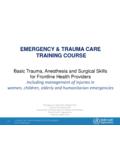Transcription of Infection Control Principles & Strategies
1 Infection Control Principles & StrategiesFocus on the Outbreak ContextDr Cath MurphyMs Sue ResnikDr Gail ThomsonDr Carmem L Pessoa-SilvaShort Course on Infectious Diseases in humanitarian EmergenciesLondon, 1stApril, Module Plan Basic IC Principles & Strategies Basics of HH, PPE, & Isolation Precautions The outbreak context ScenariosBasic Principles of Infection ControlChain of InfectionIn order to Control or prevent Infection it is essential to understand that transmission of a pathogen resulting in colonisation or Infection requires the following 5 vital links:AgentAgentSourceSourceMode ofMode oftransmissiontransmissionPortal of entryPortal of entryinto the hostinto the hostSusceptible hostSusceptible hostAgentTypes of potential pathogens Health care setting Health care can be at home, community centres, hospitals, etc. Primary source = patient (secretions, excretions, body fluids, respiratory aerosols) Non-health care setting Farms, etc Primary source = animals, plantationRisk of InfectionNever forget the manikin s head and neckContaminated intubationequipmentMain Modes of Transmission Contact Direct contact Common vehicle Droplet (large aerosols) Airborne tiny aerosols (droplet nuclei) over long distance VectorModes of TransmissionRespiratory Aerosols Respiratory aerosols comprise Droplets = large aerosols, size 5 m Droplet nuclei = tiny aerosols, size < 5 mPredicted Infection Risk as a Function of the Ventilation Rate and the Quanta GenerationCourtesy Prof.
2 Y. Li, Univ Hong KongExposure period: h The quality of ventilation has been pointed as a major factor in determining the risk of K, Nardell E. The relative efficacy of respirators and room ventilation in preventing occupational tuberculosis. Infect Control Hosp Epidemiol. 1998;19(10) of Entry into the HostTo cause disease, the infectious agent must first gain entry into the human body. Common portals of entry include: Respiratory tract Gastrointestinal tract Mucosa ( , conjunctiva, nose, mouth) Genitourinary tract Breach of skin integrity Mosquito biteBasic Infection Control StrategiesInfection Control StrategiesAgentAgentSourceSourceMode ofMode oftransmissiontransmissionPortal of entryPortal of entryinto the hostinto the hostSusceptible hostSusceptible hostAIM: BREAK LINKSAIM: BREAK LINKSB reaking the Chain of InfectionActions targeting the links Source Control measures , cough etiquette, elimination of hazardous materials, cleaning, disinfection Modes of transmission Contact: hand hygiene Droplet: distance from the source >1 m Airborne: ventilation of the space Vector: nets Portal of entry into the host Adding barriers, , PPE Host Enhancing defence, , vaccination IC Precautions.
3 Health Care vsNon-health Care SettingsIssues that impact on type of precautionBetter Control through policies & structuresUnpredictable Controllability over the settingInvolves fine and precise acts with patients Frequently heavy duty TaskMainly through direct and close contact with patientGreater importance of the environment (dust, risk of injuries, etc.)Mode of transmissionPatient Animals, plantation, HC settingNon-HC settingIssue IC Precautions in Non-health Care Settings Frequent need to Cover the whole body: , environment heavily soiled with contaminated dust Protect the feet against injuries with resistant shoes ( , boots) Perform heavy duties that may disrupt the protective barrier, resulting in need for additional resistant barriers ( , rubber gloves and apron). Infection Control StrategiesConclusion Administrative Controls Programmes, policies, procedures Triage, organization of work Engineering Controls Environmental ventilation (air exchanges) Personal Protective Equipment based on the isolation precaution indicated for the situationStrength of measureOutbreak settings: Frequent problems NO IC structure NO IC Policy Infrastructure NO electricity, NO running water Overall bad maintenanceHand Hygiene and Personal Protective Equipment (PPE) Isolation Precautions in HC Standard Precautions Routine precautions to be applied in all situations for all patients Additional Precautions For specific patients/diseases Contact Precautions Droplet Precautions Airborne PrecautionsStandard Precautions in HCProviding the Foundation To limit/prevent contact with all secretions or biological fluids, skin lesions, mucous membranes, and blood or body fluids.
4 Includes direct or indirect contact Dealing with individuals Dealing with the environment Main foundations Clean/safe environment Hand hygiene Use of PPE based on risk assessmentThe Role of Hands in Disease Transmission2. Organisms transferred to survive for several minutes4. Hand hygiene inadequate or omitted or agent inappropriate 5. Hand has contact with another patient or the environment1. Organisms on patient s (pts) skin or environmental settings: If hands are soiled with dirt or secretions = WASH HANDS WITH SOAP & care settings: unless hands are visibly soiled, alcohol based hand rubs should be used, if Hygiene Wearing gloves does not remove the need to perform hand hygiene after glove parts missedHand HygieneLink to annexHand Hygiene TechniquePPE for Standard Precautions BASED ON RISK ASSESSMENT IF direct contact with blood & body fluids, secretions, excretions, mucous membranes, non-intact skin Gloves PLUS gown+PPE for Standard Precautions BASED ON RISK ASSESSMENT IF there is the risk of spills onto the body and face: Gloves PLUS gown PLUS Face protection (mask plus eye protection goggle orvisor.)
5 Face shield)++ORORPPE for Specific Precautions Directed to specific diseases Some disease may require a combination of specific precautions Contact Precautions Gloves PLUS gown Droplet Precaution Medical mask Airborne Precaution Particulate respirator+How to use PPEP reparation Hazard identification and risk assessment Guarantee hand hygiene conditions Access to hand rub or Access to sink + soap + single use towel Guarantee necessary PPE items Well placed When neededFew Issues BEFORE Putting on PPE Where are you going to put on PPE? Do you need assistance? Where and how are you going to take PPE off? What will you do with the waste generated?Key points for safe practice PPE BREACHES may occur Try to work with another person, a buddy . This can provide informal feedback on performance. PPE may Restrict the wearer by limiting movement or visibility Cause discomfort and thus facilitate breaches Additional layers do NOT ADD protection, but discomfort Try to ensure cleanliness and orderliness of the worksite Remove PPE immediately after useGloves Intended to prevent skin contact with hazardous substances, body fluids Do you have an allergy to latex?
6 Alert the team leader / whoever in charge of PPE Do not reuse disposable gloves Change gloves between patients, perform hand hygiene & put a clean pair on Don't apply HH products on latex glovesGown Protects skin and prevents soiling of clothing during procedures that are likely to generate splashes or sprays of blood, body fluids, secretions, or excretions. Select a gown that is appropriate for the activity and amount of fluid likely to be encountered. Remove a soiled gown as promptly as possible and wash hands to avoid transfer of micro organisms to other patients or for non-health care settingsApronApron may be wornif there is concern oversplash with infectiousbody fluids AND-The coverall/gown is not impermeableOR-Heavy duty with risk of disrupting the coverall/gown Protection of Facial Mucosa Protect mucosa of mouth, nose AND eyes Protection of mucosa of mouth and nose Mask OR Face shield Eye protection Visor OR Goggle OR Face shield If face is splashed, wash it immediately!
7 ORORORERROR: stackunderflowOFFENDING COMMAND: ~STACK.














